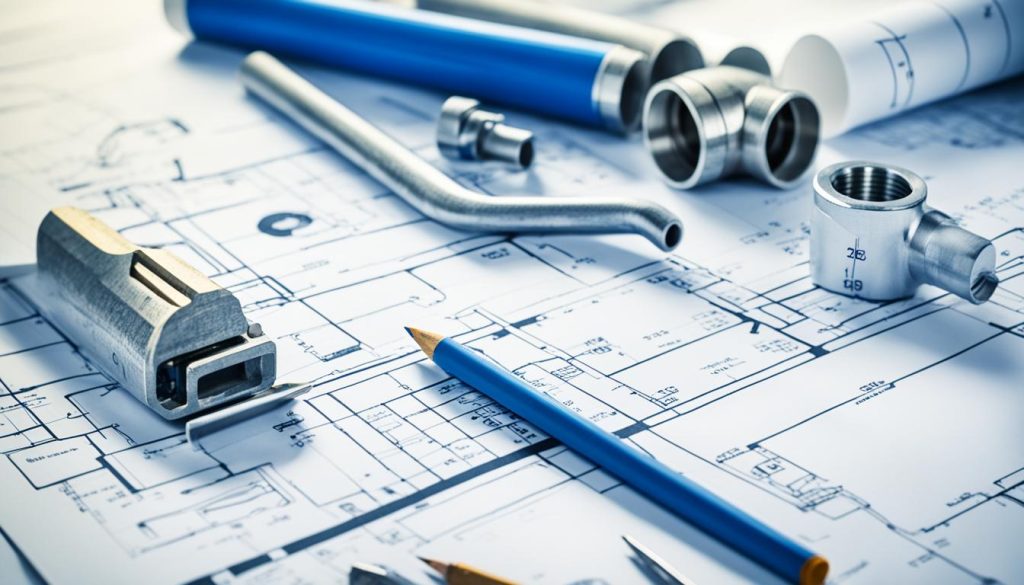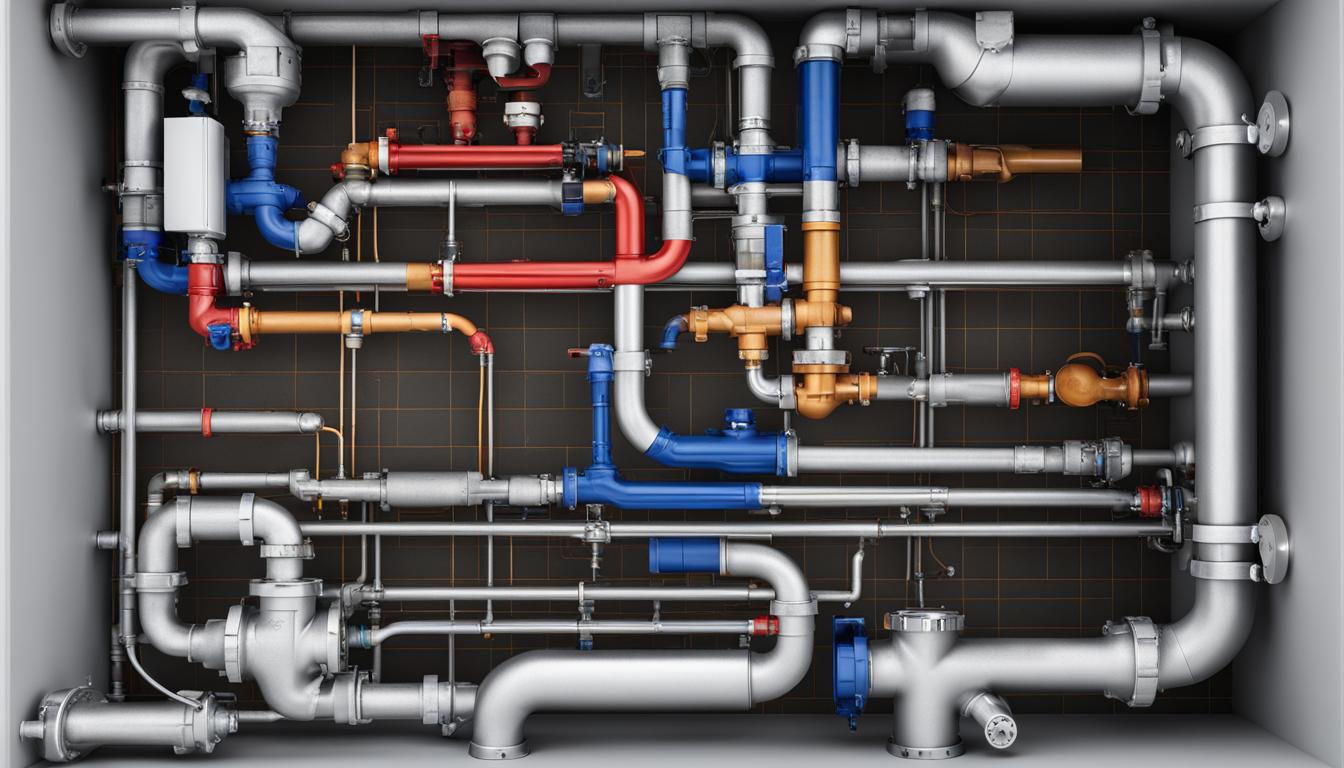Did you know that the ideal profit margin for plumbers is 35%? According to the Mechanical Contractors Association of America (MCAA), this percentage ensures that plumbers can maintain profitability while providing quality services. But how do plumbers arrive at accurate estimates that align with this profit margin? Let’s explore the key factors and strategies involved in estimating plumbing costs and creating detailed estimates that both plumbers and customers can rely on.
Key Takeaways:
- Accurate estimates help plumbers ensure profitability and build customer trust.
- Consider factors like location, service type, materials, and accessibility in plumbing cost estimation.
- Hourly, flat-rate, and square foot estimates are common methods used in plumbing cost calculation.
- Steps to creating a plumbing estimate include evaluating the problem, researching local rates, determining material costs, and calculating additional expenses and labor hours.
- To save on plumbing costs, invest in durable materials, perform regular maintenance, address issues promptly, and compare quotes from multiple plumbers.
Types of Plumbing Estimates Examples
When it comes to estimating plumbing costs, there are three common types of estimates: hourly, flat-rate, and square foot estimates.
Hourly estimates are calculated based on the plumber’s hourly wage and the number of hours spent on the job. This type of estimate offers flexibility but can be less predictable in terms of the final cost.
Flat-rate estimates provide a fixed cost for a specific plumbing job, regardless of the time it takes to complete. This type of estimate offers certainty for customers, as they know the exact price upfront.
Square foot estimates calculate costs based on the size of the space and the complexity of the plumbing system. This type of estimate is commonly used in construction projects where plumbing needs to be closely aligned with the overall size of the structure.
Each type of estimate has its advantages and suits different situations. Hourly estimates allow for flexibility and adjustability, flat-rate estimates provide certainty, while square foot estimates are useful for construction projects. Let’s examine each type of estimate in more detail.
Hourly Estimates
Hourly estimates are based on the plumber’s hourly rate and the number of hours spent on the job. This type of estimate is typically used for jobs that have an uncertain scope or are difficult to predict in terms of the amount of work required.
For example, if you need a plumber to fix a small leak under your sink, they may provide an hourly estimate based on their standard rate. The estimate will include the estimated number of hours to complete the job.
It’s important to note that hourly estimates can be subject to variations in the final cost depending on the time taken to complete the job. Factors such as unforeseen complications or difficulties encountered during the process can impact the final bill.
Flat-Rate Estimates
Flat-rate estimates offer a fixed cost for a specific plumbing job, regardless of the time it takes to complete. This type of estimate is commonly used for straightforward jobs with a well-defined scope and predictable timelines.
For instance, if you need to have a new toilet installed, the plumber may provide a flat-rate estimate that includes all the necessary labor and materials. With a flat-rate estimate, you’ll know the total cost upfront, providing transparency and peace of mind.
Square Foot Estimates
Square foot estimates calculate plumbing costs based on the size of the space and the complexity of the plumbing system. This type of estimate is often used in construction projects, where plumbing needs to be integrated into the overall design and build.
For example, if you’re constructing a new house or adding an extension, the plumber may provide a square foot estimate based on the square footage of the area. This estimate will consider factors such as the number of bathrooms, kitchens, and fixtures required, as well as the complexity of the plumbing installation.
Now that we’ve explored the different types of plumbing estimates examples, it’s important to consider which type is most suitable for your specific project. Whether you opt for an hourly estimate, flat-rate estimate, or square foot estimate, understanding how each type works will help you make informed decisions and ensure accurate budgeting.
Factors Affecting Plumbing Costs
When determining the cost of a plumbing service, there are several factors to consider. These factors play a crucial role in calculating the overall expense. Understanding these plumbing cost factors can help you prepare a more accurate estimate for your clients.
1. Location
The location of the plumbing project can have a significant impact on labor rates. In denser urban areas, the cost of hiring a plumber is often higher compared to suburban or rural locations. It’s essential to consider the local market conditions when pricing your services.
2. Type of Service
The type of plumbing service required will also affect the cost. Whether it’s a repair, installation, or routine maintenance, each service varies in complexity and time required to complete the job. It’s crucial to assess the scope of work to provide an accurate estimate.
3. Materials and Fixtures
The choice of materials and fixtures for the plumbing project will impact the total cost. Higher-quality materials and fixtures typically come with a higher price tag. It’s important to factor in these costs when preparing your estimate to ensure accuracy.
4. Extent of the Problem
The severity and complexity of the plumbing problem will influence the cost of the service. Simple repairs may be less expensive compared to more extensive issues that require significant repairs or replacements. Proper assessment of the problem is crucial for an accurate estimate.
5. Accessibility
The accessibility of the plumbing system can also impact the overall cost. Working in tight or hard-to-reach spaces, such as cramped crawl spaces or older homes with outdated plumbing, may require additional labor and resources, resulting in higher costs.
By considering these plumbing cost factors such as location, type of service, materials and fixtures, extent of the problem, and accessibility, you can provide accurate and transparent estimates to your clients, allowing them to make informed decisions about their plumbing projects.
Stay tuned for the next section, where I will walk you through the process of creating a plumbing estimate.
Steps to Creating a Plumbing Estimate
Creating an accurate plumbing estimate is essential for ensuring transparency, setting fair prices, and providing reliable service to customers. Follow these steps to create a comprehensive plumbing estimate:
- Evaluate the extent of the problem: Begin by conducting a thorough inspection of the plumbing system to identify any issues and assess the complexity of the job.
- Research local labor rates: Determine the competitive and fair hourly rate for your estimate by researching the prevailing labor rates in your area.
- Determine material costs: Research the prices of pipes, fittings, valves, and fixtures to accurately estimate the cost of materials required for the job.
- Factor in additional expenses: Consider any additional expenses, such as permits, disposal fees, or specialty tools, and include them in your estimate to provide a comprehensive breakdown of costs.
- Calculate labor hours: Based on the scope of the job, calculate the estimated number of labor hours required to complete the project. Be sure to include a contingency amount to account for any unforeseen circumstances or delays.
- Calculate the total cost: Sum up all the costs, including labor costs, material costs, additional expenses, and the contingency amount, to determine the total estimated cost for the plumbing job.
By following these steps and considering all the relevant factors, you can create a thorough and accurate plumbing estimate that aligns with industry standards and provides transparency to your customers.
Example Plumbing Estimate Calculation:
| Item | Cost |
|---|---|
| Labor (12 hours) | $900 |
| Materials | $500 |
| Additional Expenses | $150 |
| Contingency | $100 |
| Total Estimate | $1,650 |
Remember, each plumbing project is unique, and it’s important to tailor your estimate to specific requirements. Accuracy, transparency, and clear breakdowns of costs will help you establish trust with your customers and ensure a successful plumbing project.

Tips for Estimating and Saving on Plumbing Costs
When it comes to estimating plumbing costs, accuracy is key. Here are some tips to help you create a detailed estimate that ensures transparency and avoids any surprises down the line.
To begin, gather all relevant information about the plumbing system and potential issues. Conduct a thorough inspection to identify any underlying problems that may impact the cost. Research local labor rates to set a competitive hourly rate for your estimate. Determine material costs, taking into account different options that suit your budget and requirements. Don’t forget to add any additional expenses such as permits or disposal fees.
Calculating labor hours is another crucial step in creating an accurate estimate. Consider the complexity of the job and any unforeseen circumstances that may require extra time. Combine all these factors to create a detailed estimate that presents a clear breakdown of costs, giving your customers confidence in your professionalism.
To save on plumbing costs, there are a few strategies you can implement. Opting for durable materials may have higher upfront costs, but they can save you money in the long run by reducing the need for frequent repairs. Regular maintenance and addressing issues promptly can also prevent more costly problems from arising in the future. Additionally, it’s wise to get multiple quotes from different plumbers to ensure competitive pricing and value for money.
